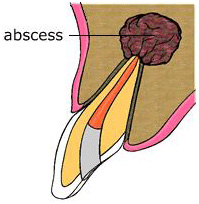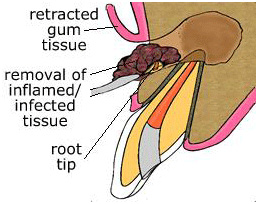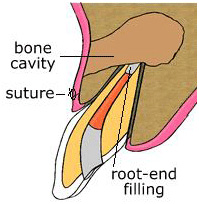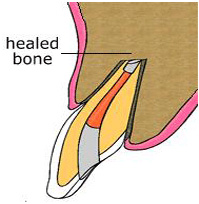Apicoectomy
Occasionally the pain and infection from a long standing decayed tooth may not be completely eliminated by root canal treatment alone. In such case an apicoectomy may need to be done.
What is an Apicoectomy?
An Apicoectomy, or Root-End Resection, is the removal of the root tip and the surrounding infected tissue of an abscessed tooth. This procedure may be necessary when inflammation and infection persists in the area around the root tip after root canal therapy or root canal retreatment:
Step one: After the tooth is "numbed", the gum is reflected (lifted) to uncover the underlying bone and the root end of the tooth. The root-end is resected (removed) with all the surrounding infected tissue.
Step two: A root-end filling is placed to seal the end of the root canal, the gum is repositioned, and a few dissolvable sutures (stitches ) are placed to hold the gum tissue back in its place until healing occurs.
Step three: After a few months, the bone around the root-end has healed, and all symptoms are gone.

STEP 1

STEP 1

STEP 2

STEP 3
Post Surgical Instructions
- Do not lift or pull on lips. This may cause tearing out of the sutures.
- Some swelling and discoloration is normal and will gradually disappear.
- To minimize swelling, use ice pack application on the face, over the operated area. The pack should be used - on for 20 minutes, off for 10 minutes - and should be continued during the first day only.
- Starting tomorrow, rinse with warm salt water (one teaspoon to 8 oz. of warm water), as often as possible. Continue this rinsing for one week.
- Eat foods that will be nourishing but will not require vigorous chewing the first few days, i.e., eggs, soups, milk shakes, etc.
- Slight bleeding, pain or swelling, during the first couple of days, is normal.
- Brush your teeth, being extremely careful in the operated area. Mouthwash may be used.
- For pain - ibuprofen is recommended. Follow the instruction of the your doctor concerning your medication(s).
- If there is an elevated temperature, excessive bleeding, swelling or uncontrolled discomfort, please call the office.
- There will be at least two follow-up appointments. The first follow-up will be in a few days to have your sutures removed. The second appointment will be after a few weeks, so that we may evaluate the soft tissue (gum) healing. Additional follow-up appointments may be necessary.
- We routinely like to perform a follow-up exam at least six months after the treatment. We want to evaluate the treatment outcome, be sure that you have regained normal function with the tooth, and determine the presence of bone healing. There is no charge for this visit.



